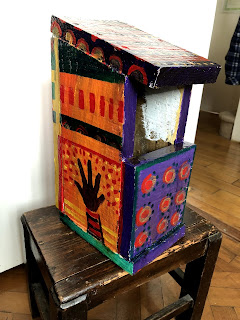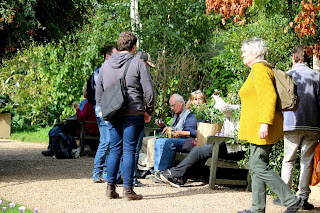Before tackling the Hidden Pond Area
there were some trees to plant
and eggs to collect
Green Patch cats Rosemary
and Basil
The pond had become very
overgrown with reeds and weeds
We began moving the silted tyres
and hope to replant them later on
It is heard to know quite where to begin but we have had some wonderful plans and advice from
Ann Leonard who is used to dealing with huge pond projects through her role as Office Manager at
AES Europe and who is a long time participant, supporter and friend of Back To Books. Ann came to visit the site during the planning stages of the project in August and has given us three options to look at.
Green Patch Pond
Option 1
Judiciously prune trees to achieve dappled shade.
Cut back or remove shrub.
Clear out reeds from pond – leave to one side so that pond dwellers can find their way to safety.
Remove tyres.
Reassess the situation. It may be the path of least resistance to trim back the liner to 8 inches from the edge of the pond, install marginal plants round the perimeter and plant up some baskets to put on the shelves.
Allow the pond to fill naturally
Plant list 1 - Marginal
Water forget-me-nots – Mysotis scorpioides (easy from seed)
Molly blobs - Caltha palustris
Brooklime - Veronica beccabunga (easy from seed)
Creeping Jenny – Lysimachia nummularia
Purple loosestrife - Lythrum salicaria
Ox eye daisy - Leucanthemum vulgare - (easy from seed)
Marsh woundwort - Stachys palustris
Baskets filled with a loamy compost , planted and a layer of gravel to prevent soil floating out. Suggest planting a tall plant from below with a couple of menthe aquatic strands.
Flag iris (yellow)
Purple iris
Butumos
Orontium aquaticum
Option
2
As
option 1 to point 4.
5.
As there is excess liner it would be possible to excavate a shallow
trench under it to add a channel to make a space for bog plants.
The channel must be deep enough to contain soil and plants and leave
a significant border of liner to “tuck” under the turf round the
pond . It is not necessary to surround the entire pond with bog
plants, a narrower cut could be made and marginal plants from the
option 1 list planted.
Planting
would be as Option one plant list for baskets and marginal plants
Option
2 bog plants
Astilbe
–
red, white and pink shades available
Houttuynia
cordata
Hostas
– species
for damp shade
Geum
Rivale
Mentha
aquatic
Aquatic
plant seeds – it is possible to grow aquatic plants from seed –
Forget-me-nots, Brooklime, and Butumos are easy – but Butumos takes
several years to flower… could be grown on in baskets over a period
of years to replace plants at a later date. Other seeds are
available – it may be an interesting project to “grow your own”
for volunteers.
Mysotis
scorpioides
Option
3
1
Prune trees and remove/cut back shrub/
2
Clear pond entirely including liner
3
Measure fibre glass liner and ensure it will fit in the hole.
Excavate where necessary. Aim to have the edges very slightly below
the level of the surrounding land, definitely not higher, to allow
water runoff from the local area to fill the pond.
4)
Line the bottom of the hole with sand. Check depth again. Ensure the
pond bottom is absolutely level.
5)
Brace the dipped side of the fibre glass shell with wood or bricks to
ensure that the level is perfect.
6)
Backfill with whatever is available. Hardcore or crushed aggregate
could go at the bottom, sand then whatever soil is available.
7)
The new area surrounding the pond will need to be graded (made to
slope) downwards into the pond.
Plants
for baskets as previous options.
As
the fibreglass shell has a very narrow lip it would be very easy to
achieve some interesting planting effects. Enthusiastic creeping
plants like Brooklime and Creeping Jenny would be ideal to offer an
open aspect opposite tall plants like Purple Loosestrife.
Further
thoughts.
In
the medium term once the pond is stable it will need to be
maintained, plants cut back in February etc. Overgrowth will need
to be curtailed – plants can be divided up and planted elsewhere.
The
presence of newts make me think it would be a good idea to create a
newt hotel for hibernation. Pile of sticks 60cm high and 100cm long
covered loosely with turf.
The
area to the left of the pond next to the fence nearest the other
pond rather lends itself to a willow hut with some tree trunk sttols
for a story telling area.
The
ponds need aeration a solar powered floating pump would be useful
for both.
The
iris basket in the square pond needs hauling out and the rhizome
sawing up to create new plants.
Don’t
put tap water in the ponds… it has a massive amount of nutrients
which will encourage algae to grow.
It seems daunting but we will get there!






























































